Lab ACSE
 {width=50%}
{width=50%}
There are several variants of LR parsers, one of them are LALR parsers. LR (and LALR) parsers can be generated by a parser generator from a formal grammar defining the syntax of the language to be parsed. This is what Bison (GNU Parser Generator) does: it’s not a parser but a parser generator. Bison uses the LALR(1) parsing algorithm, LALR(1) stands for “Look-Ahead LR(1)” which is an efficient bottom-up parsing algorithm. LALR(1) builds a parse tree for a given input string by starting at the leaves and working its way up to the root. It’s an efficient algorithm for parsing context-free grammars. LALR(1) languages are strictly less expressive than general context-free languages, but are more efficient to parse.
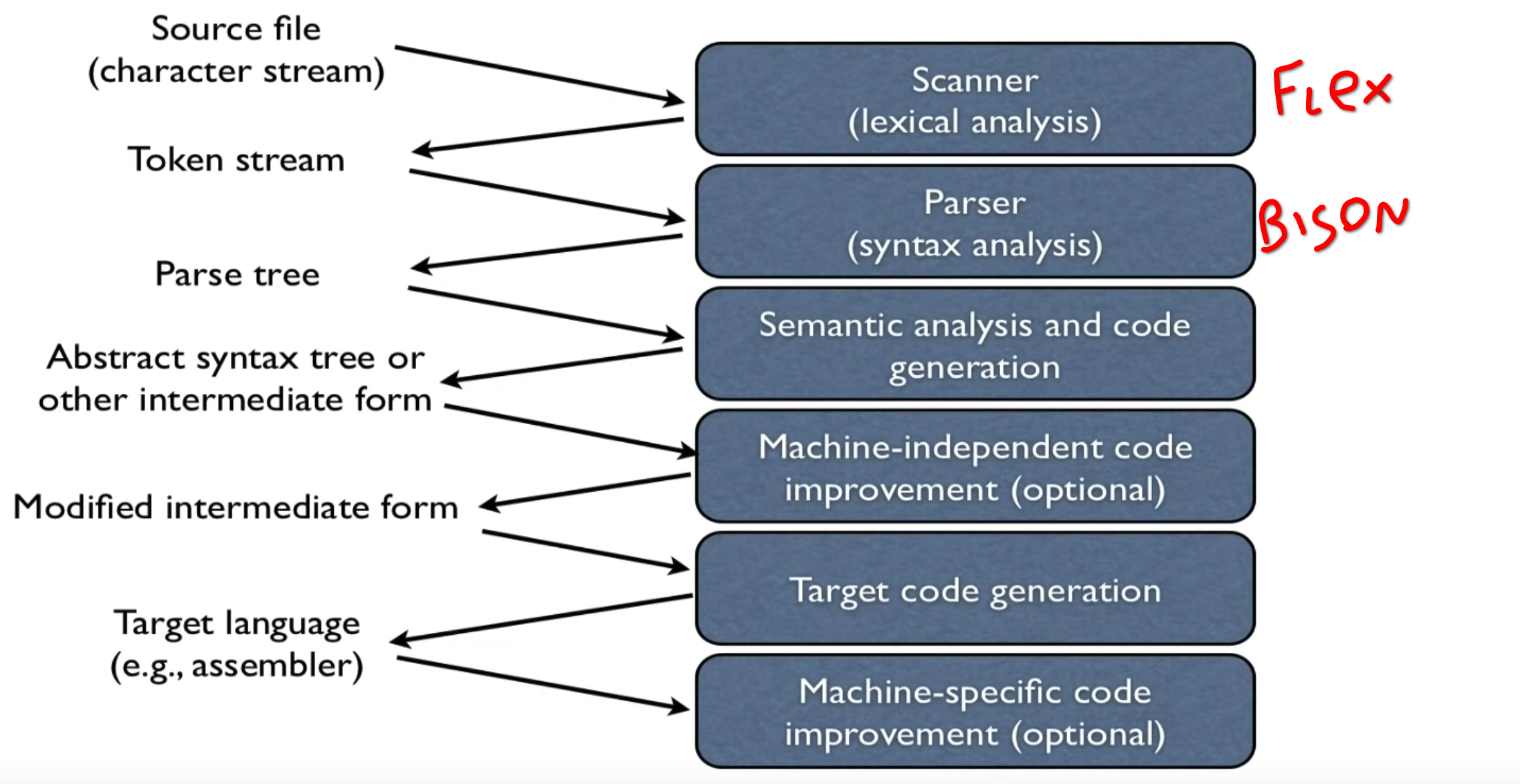
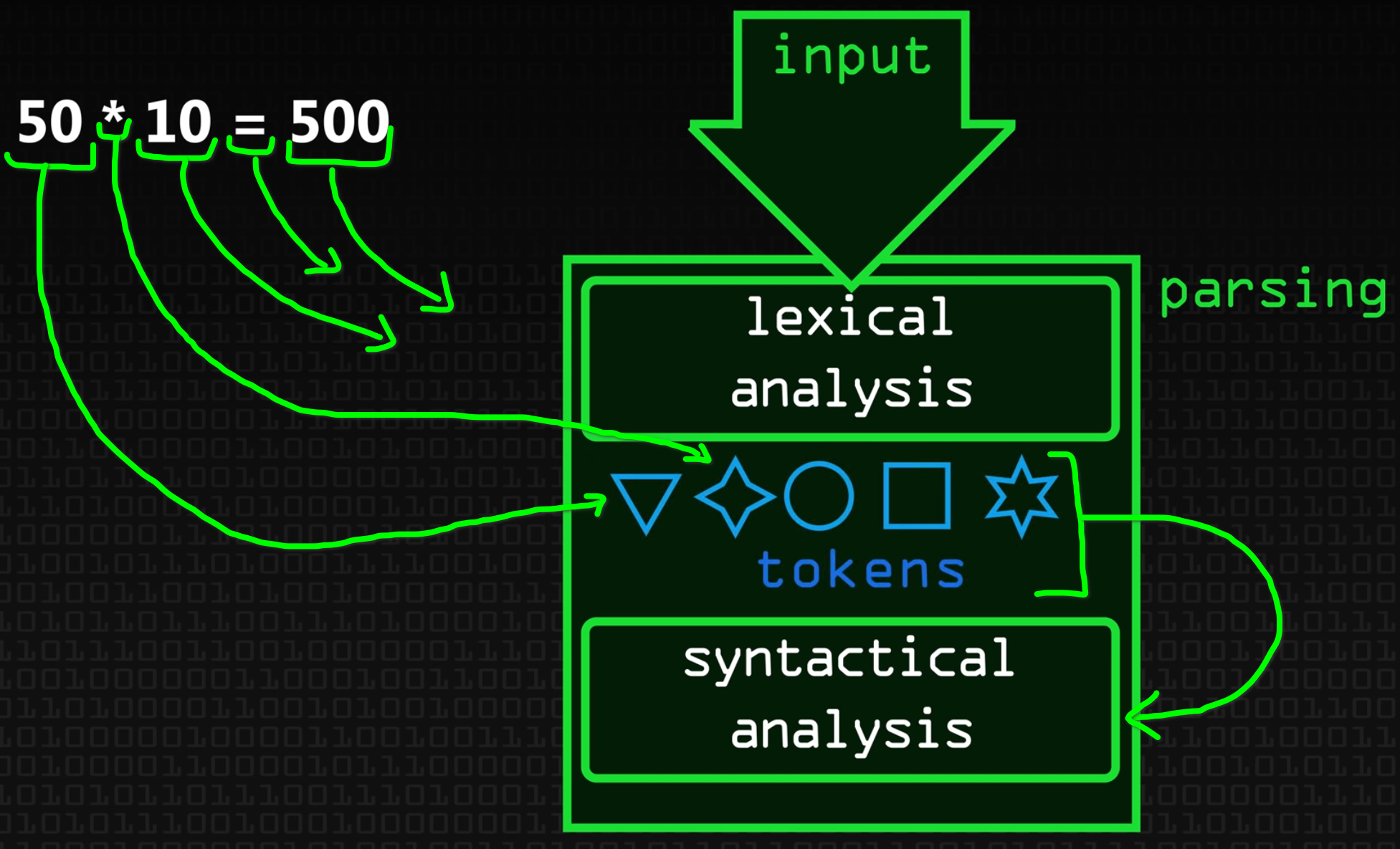
Mindset: in this kind of exercises we are not actually doing assignments, we are just writing the instructions that will produce the assignment when the program will be executed. We are translating the program, not executing. Compilation is a form of planning. No space for its value is reserved in the memory of the compiler, however, the compiler knows in which register or memory location the variable will be at runtime.
sudo apt update && sudo apt install –y build-essential flex bisonIn acse the assembly code is generated while the parser (generated by Bison) is parsing (using the Bison semantic rules).
Flex

It’s implemented as non-deterministic finite state automaton.
- definitions: where you can declare useful REs
- rules: most important part where you bind RE combinations to actions
- user code: C code
Each part is separated by ``` Rules //bind RE combinations to actions
//rules like a context-free grammar
not_terminal : terminal1
| terminal2 TOKEN_A
| terminal3 { /* C code */ }
%%
//user code
Very similar to grammar ... uppercase tokens are non terminals and lowercase tokens are terminals symbols.
You can add semantic actions for each grammar rule.
Byson uses bottom-up parsing: it always gives precedence to the inner-most rule.
````C
%union{ //in the %union I list the possible semantic data types
float f_value;
struct Expr expr;
}
//Here I specify the type which the tokens can assume:
%token <f_value> FLOAT //%token are terminals
%type <expr> expr //%type are non terminals
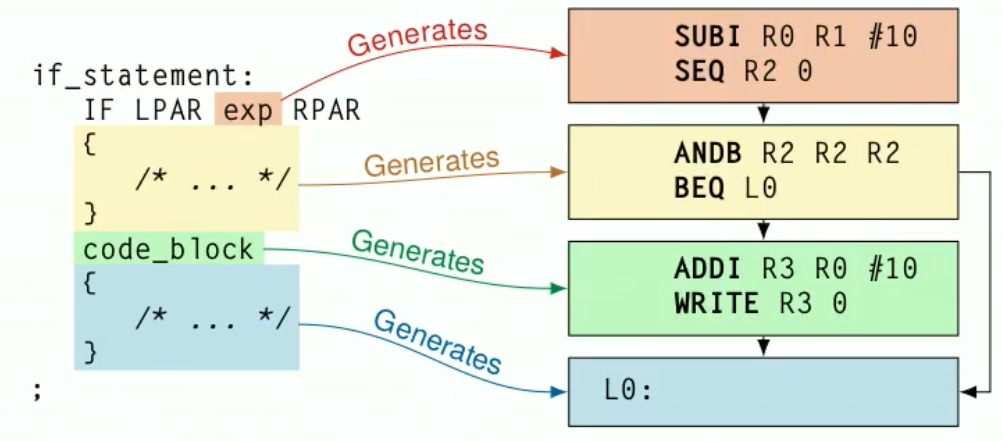
The parser generated by Bison would be responsible for recognizing and parsing the ACSE code while the lexical analyzer (generated by Flex) would be responsible for breaking the code up into individual tokens.
ACSE

Acse is a LANCE ( a simplified version of C) compiler which emits RISC-like assembly code and is built on Flex and Bison.
ACSE is a simplified compiler in order to reduce the effort to understand how compilers work. ACSE accepts a C-like source language called LANCE:
• very small subset of C99
• standard set of arithmetic/logic/comparison operators
• reduced set of control flow statements (while, do-whi le, if)
• only one scalar type (int)
• only one aggregate type (array of ints)
- only two I/O operations:
read(var)stores into var an integer read from standardwrite(var)writes var to standard output writing
LANCE produces a RISC-like assembly language:
| Type | Operands | |
|---|---|---|
| Ternary | 1 destination and 2 source registers | ADD R3 R1 R2 |
| Binary | 1 destination and 1 source register, and 1 immediate operand | ADD R3 R1 #4 |
| Unary | 1 destination and 1 address operand (label) | LOAD R1 L0 |
| Jump | 1 address operand | BEQ LO |
Jump instructions:
- BT: unconditional branch
- BEQ: branch if last result was zero
- BNE: branch if last result was not zero
Using ( ) to point to the memory address.
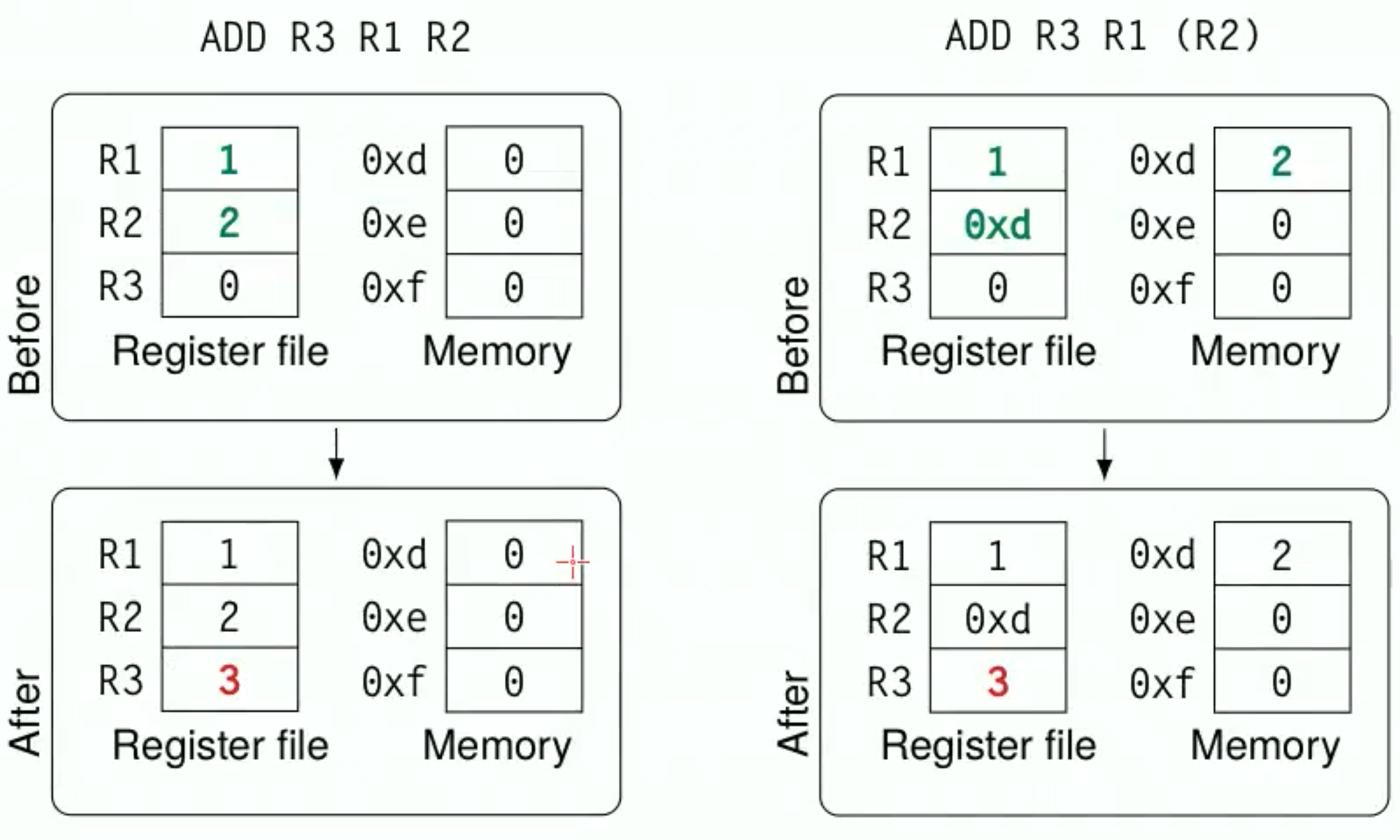
Special registers:
R0zero, always contains 0- status word
PSW, mainly exploited by conditional jumps- N, negative
- Z, zero
- V, overflow
- C, carry
ACSE works using mace which is a simulator of the fictional MACE process.
Compiler translates a program written in a language and it’s organized as a pipeline:
-
front-end: source language into intermediate forms
-
middle-end: where transformations and optimizations are applied (for example vectorization)
-
back-end
-
Front-end: the source code is tokenized by a flex-generated scanner, while the stream of tokens is parsed by a bison-generated parser. At the end, the code is translated to a temporary intermediate o a representation by the semantic actions in the parser.
-
No middle-end since no optimizations are made
-
Back-end: we use the MACE processor
A real-world example of a compiler is LLVM.

The theory part of the course mainly focused on the frontend:

ACSE has:
- reduced set of control flow statements (while, do-while, if)
- only one scalar type (int)
- only one aggregate type (arrayofuints)
- no functions
- limited I/O (just
read(var)andwrite(var))
Why this language? This is an ¨academical” language and its focus to education. So there is basically nothing so that they can ask stuff to be implemented during the exam.
The parser (Bison) modifies the intermediate languages made of variable and instructions list. Then backend process it.
Precedence and associativity of expressions are handled by Bison.
Constant folding: optimization to “merge” constants at compile time.
To do this we use a structure which memorize the “value” and the type “IMMEDIATE|REGISTER”. If at compile time there is a sum of two immediate, they will merged inside a single immediate.
To do this, you will use:
handle_bin_numeric_op() //Arithmetic and logical operations
handle_binary_comparison() // Comparisonsat the exam the grammar part is the most easy part. The difficult part is the semantic action.
Tip: It’s always useful to “de-sugar” a construct you are implementing to clear up any doubt you might have about its implementation
for syntax sugar → any for can be replaced with while
If in Bison part we use ” $2” we refer to the second token
Semantic actions are independent blocks or scopes and variables declared in a semantic action are local to that action! Our exam consists in:
- add tokens modifying Flex (lexical)
- add grammar rules to recognize new constructs using Bison (syntactic)
- write semantic actions to generate code for new constructs
In particular:
- add the “keyword” to the Flex token declaration:
"keyword" { return KEYWORD_TOKEN }
- then in Bison (
Acse.y) we place the token definition:%TOKEN KEYWORD_TOKEN
- Then you have to define the syntactic rules or modifications to existing one.
- Define the semantic actions needed to implement the required functionality, always in
Acse.y. General stuff in the exam could be:- generate a custom structure to manage results
- use some of the 3 possible techniques to manage nesting expressions and the “stack”.
- modify existing code
resources:
Acse.lex: flex source (scanner)Acse.y: Bison syntax grammar of LANCE inAcse.y. The semantic actions are responsible for the actual translation from LANCE to assemblycodegen: instruction generation functions:aze_gencode.hwhere there are all the helper functions to generate assembly.
approach:
- read the text
- rewrite the text using a snippet of pseudo code
- add the tokens needed in the
Acse.lex
[0-9]+ { yylval.value = atoi(yytext);
return X; }
- add the tokens in
Acse.ywith%token.
%token <value> X
- Is it a statement or an expression? You have to decide it.
- add the “rule like a context-free grammar” in the
Acse.yand so the semantic action - for the semantic action we probably need to define a struct in the
acse_struct.hassociated with what we are adding - any new struct declared as to be added as an item in the
%union{ <here> }] ?? - add the struct declared to the new token ] ??
ACSE Cheatsheet
Basics
- In order to use a value of an identifier non-terminal, we have to know where the variable is located (in which register). The function
get_symbol_locationis used in order to retrieve the register location assigned to a given identifier.int reg = get_symbol_location(program, $NUM, 0);. The returned value is not the value contained in the register but the number of the register we need to use in the instructions!
- always free
$NUMthe identifiers at the end
- in a statement it makes no sense to use $$ because I don´t have to pass any value to the caller
- $$ cannot be assigned in a midrule action
Check if a nonterminal (usually exp) is an immediate or a register:
// after this piece of code you can handle expression not caring if it is immediate or register
if ($2.expression_type == IMMEDIATE) {
gen_addi_instruction(program, value, REG_0, $2.value);
} else {
gen_add_instruction(program, value, REG_0, $2.value, CG_DIRECT_ALL)
}- Copying the value of a register type nonterminal into another already initialized register:
gen_add_instruction(program, dest_reg, REG_0, $NUM.value, CG_DIRECT_ALL);
- Adding another register value into a register:
gen_add_instruction(program, dest_reg, dest_reg, source_reg, CG_DIRECT_ALL);
Immediates
- Creating a new register:
int reg = getNewRegister(program); - Creating a register and assigning an immediate value (in this case value assigned = 0 ):
int r_i = gen_load_immediate(program,0); //it returns registry ID- Move an immediate value into a register
void gen_move_immediate(program, int dest_reg, int imm); Variables
typedef struct t_axe_variable {
int type;
int isArray;
int arraySize;
int init_val;
char *ID;
t axe label *label ID;
} t_axe_variable;- Get variable from token with
getVariable(program,char * id):
t_axe_variable *v_dst = getVariable(program,$1)
t_axe_variable *v_src1 = getVariable(program,$3)
t_axe_variable *v_src2 = getVariable(program,$5)t_axe_expression handle_bin_numeric_op(program,
t_axe_expression exp1,
t_axe_expression exp2,
int binop);binop = `ADD, ANDB, ANDL, ORB, ORL, EORB, EORL, SUB, MUL, SHL, SHR, DIV
Arrays
t_axe_variable *d_array = getVariable(program, $1);
t_axe_variable *s1_array = getVariable(program, $3);
t_axe_variable *s2_array = getVariable(program, $5);
// $NUM needs to be freed at the end of code
if(!d_array->isArray || !s1_array->isArray || !s2_array->isArray)yyerror("problem");- array element into a new register
// in case of register index
int r_i = gen_load_immediate(program,2);
//r_i can be modified here
int reg = loadArrayElement(program, $NUM, create_expression(r_i, REGISTER));- alternative in case of immediate index (in this case accessing element 2):
int reg = loadArrayElement(program, $NUM, create_expression(2, IMMEDIATE));- Storing an array element into an identifier nonterminal of an array:
void storeArrayElement(program, $NUM,
t_axe_expression index,
t_axe_expression data);- Saving a nonterminal array (represented by identifier) into a variable:
t_axe_variable *array = getVariable(program, $NUM); $NUMneeds to be freed at the end of code.
Labels and branches
- Declaring label:
t_axe_label *label = newLabel(program) - Fixing label position of an already declared label in the code:
assignLabel(program, {labelname})
- Declaring label and fixing its position in the same point (use only for backwards jumps):
t_axe_label *label = assignNewLabel(program, {labelname})
- Unconditional jump to label:
gen_bt_instruction(program, {labelname}, 0)
- Jump if
r_indexis greater than array length:
gen_sub_instruction(program,getNewRegister(program),r_array->isArray,r_index)
gen_ble_instruction(program, l_exit , 0);Alternative method for jumps using handle_binary_comparison:
handle_binary_comparison(program,
create_expression(r_j, REGISTER),
create_expression(v_src1->arraySize,IMMEDIATE),
_LT_); This function generates instructions that perform a comparison between two values. It takes as input two expressions and a binary comparison identifier. Valid values for the condition are:
_EQ__NOTEQ_LT__GT__LTEQ__GTEQ_
Assigning label as global variable to a token: in the token declaration %token <label> {tokenname} then, to initialize it in the code of the rule ${num corresponding to the token} = newLabel(program) and to place it `assignLabel(program, ${num corresponding to the token})
int reg_i = gen_load_immediate(program, 0); //i=0
t_axe_label *exit_lbl = newLabel(program) ; //declare end of the loop
t_axe_label *loop_lbl = assignNewLabel(program) ; //declare start of the loop
//LOOP CONDITION
handle _binary_comparison(program,
create_expression(reg_i, REGISTER),
create_expression(s1_array->arraySize, IMMEDIATE),
_LT_); // i < size
gen_beq_instruction(program, exit_lbl, 0); // in case we skip to the end of the loop
// **************
// LOOP BODY
// **********
gen_addi_instruction(program, reg_i, reg_i, 1); // i++
gen_bt_instruction(program, loop_lbl, 0); //branch back
assignLabel(program, exit_lbl); //here is the label to exit the loopSharing variables
We have 3 ways to share variables between semantic actions, basically equivalent:
- global variable: super easy to apply but it doesn’t work if the statement is nestable.
- Re-purpose a symbol’s semantic value as a variable: one of the token is used to store the value, generally use this at the exam. Sometimes the variable is a new struct which we make.
- Stack method: most complicated one and sometimes overkill.
Global variable
Initializing a global register: int glob_reg; before the “semantic records” section in Acse.y, then initialize it with glob_reg = getNewRegister(program); before using it.
Struct in (2)
To implement the 2nd option it is usually needed to declare a new structure. How to declare a new structure:
- Add a new type to give global properties to a token
- In the token section:
%token <struct_of_token_name> token_name - Add to the
%unionstruct:t_new_struct struct_of_token_name(when I create a new struct should I always include it in the%union). - In the axe_struct.h file:
typedef struct t_new_struct{
...members/fields...
} t_new_struct- Access variables of the struct in the rule code:
$NUM.{variable name}, where obviously you the$NUMis corresponding to the token name
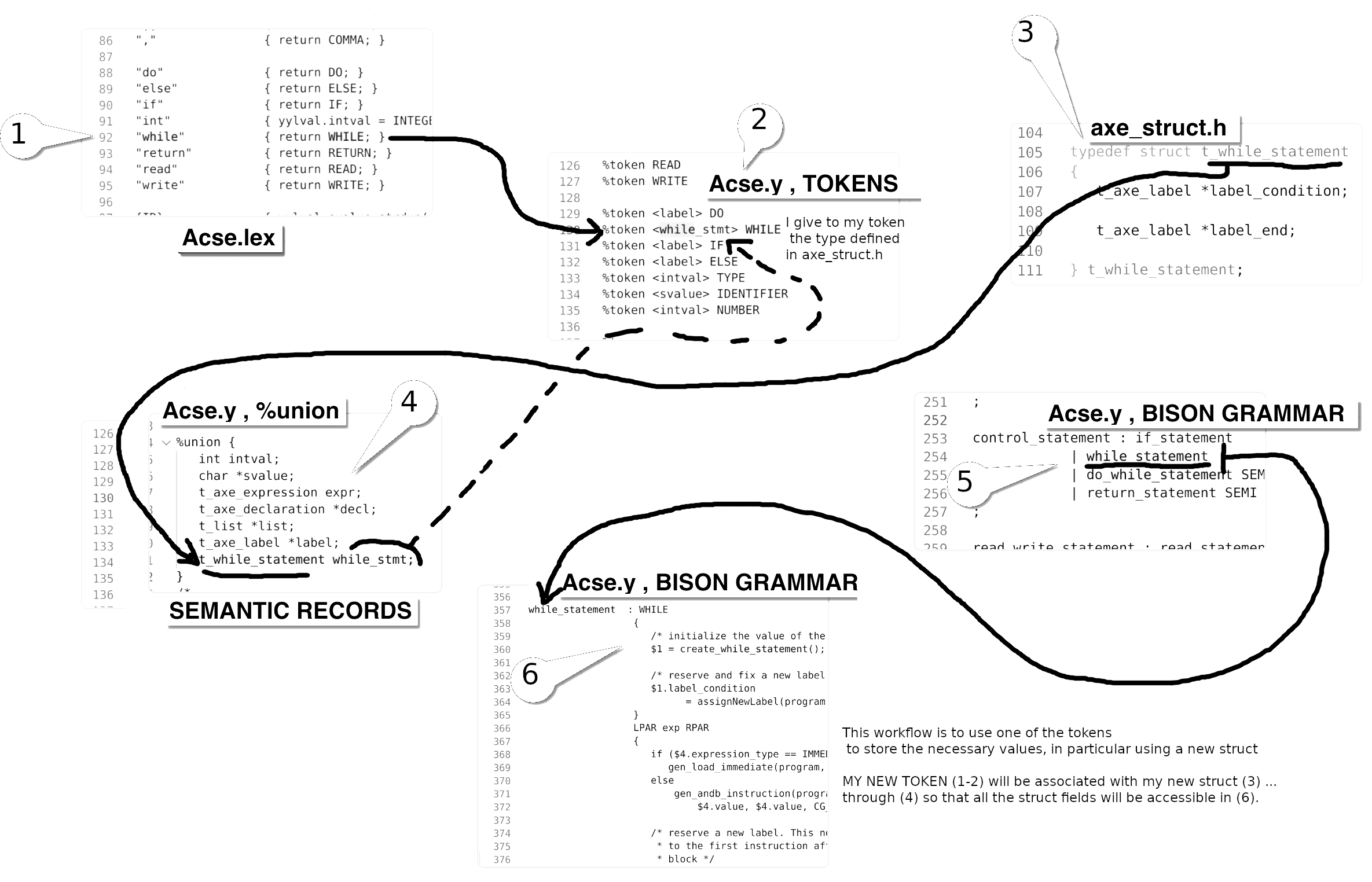
List, Stack method
2nd option is the best but not possible to do in this case to make it in nestable situation where it’s necessary to use “a stack method”. In particularly we have to use a linked list. We have the t_list struct defined in collections.h as:
typedef struct t_list
{
void *data;
struct t_list *next;
struct t_list *prev;
}t_list;And we have mainly this methods:
/*add an element `data' to the list `list' at position `pos'. If pos is
*negative, or is larger than the number of elements in the list, the new
*element is added on to the end of the list. Function `addElement' returns a pointer to the new head of the list */
extern t_list* addElement(t_list *list, void *data, int pos);
/*add an element at the beginning of the list */
extern t_list* addFirst(t_list *list, void *data);
/*remove an element at the beginning of the list */
extern t_list* removeFirst(t_list *list);The generic pattern scheme is:
- Declare in the var. declarations in acse.y the stack:
t_list *actual_stack = NULL;- then we can push:
//push
t_stack_node *top = malloc(sizeof(struct_stack_node));
top->value = get_load_immediate(program,0);
top->lbl = newLabel(program);
actual_stack = addFirst(actual_stack,top);- and pop
//pop
t_stack_node *top = (t_stack_node*)LDATA(actual_stack);
$$ = create_expression(top->value,REGISTER);
assignLabel(program,top->lbl);where to get the data associated to the list item we use #LDATA(item).
0) But we have to declare as always, in axe_struct.h, the struct we use to memorize the values to push to the stack.
typedef struct t_stack_node
{
int value;
t_axe_label *lbl;
} t_stack_node;Example of unroll it at compile time with t_list:
for(int i=0, i<array->arraySize;i++){
if(cur_list_elem ==NULL) yerror("expression list too short");
//loading the t_axe_expression
t_axe_expression *cur_list_elem_exp =
(t_axe_expression *) LDATA(cur_list_elem);
mul = handle_bin_numeric_op(program,
*cur_list_elem_exp,
create_expression(r_val,REGISTER), //an generic expression
MUL);
free(cur_list_elem_exp)
cur_list_elem = LNEXT(cur_list_elem)
}
if(cur_list_elem !=NULL) yerror("expression list too long");